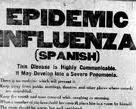Measles has been in the news recently with alerts to a possible epidemic and advice on how to protect children. How does this compare with how our ancestors coped with one of the deadliest pandemics - the flu of 1918/19?
Throughout the world it is estimated that as many as 100 million people may have died of the flu during the 1918/19 pandemic. In Europe, it is thought that the flu was introduced by members of the armed services from the USA who were sent to the Western Front. The flu then swept through the trenches.
 |
| US Soldiers suffering from flu are thought to have brought it to Europe |
Experts are unsure where the flu originated however they know that troops movements during and after the First World War helped to spread the flu to all corners of the globe.
The pandemic lasted from May 1918 until April 1919 although an increase in cases of flu was to continue into late 1919. In Scotland nearly 1 million people caught the flu out of a total population of 4.8 million and around 70,000 died from it. There were three waves of the pandemic. The first case in Scotland is thought to have been in Glasgow in May 1918.
Today we associate flu deaths with those who are vulnerable through age or illness but during the pandemic in Scotland and throughout the world, the most likely age of death from this flu was in people aged between 20 - 40. These people were often catching the flu in the morning and were dead by the same evening.
So why were so many healthy people affected so badly by this version of the flu? Doctors who have since studied this strain of flu, have discovered that when the flu came up against the immune system, it caused the immune system to overreact. This overreaction caused excess fluid to build up in their lungs and people became unable to cope. People who were the healthiest had the strongest immune systems so were most likely to be affected by a strong reaction.
There was little that doctors could do for people struck down by the flu though several possible remedies were suggested. There was also a problem on the home front as there were very few doctors as many were away in the armed forces. Those left including doctors coming out of retirement, were overwhelmed with the numbers.
 |
| The flu pandemic did not start in Spain |
The flu is commonly referred to as Spanish flu but it did not originate in Spain. During World War 1, Spain was a neutral country so unlike many other countries, it did not have an advanced use of news control.
Spain openly reported the flu pandemic, however in many other countries governments and newspapers hid the extent of the pandemic as they were afraid of the effect on the general population on hearing about so much death so soon after the First World War
As Spain had widely publicised the flu, it came to be thought that it had originated there because the earliest indications of its devastation were reported from that area.
In Scotland, most families were not left untouched by the flu pandemic. Many people will find flu as a cause of death for an ancestor but it has to be remembered that people sometimes died of related conditions so flu is not always listed as the cause of death.
The suicide rate also increased greatly during the pandemic as the flu also attacked the nervous system. If you find relations who died during 1918/19 of these related causes of death, it is worth looking further to find out if the death may have been a complication of flu.
For advice on how to identify possible flu victims, please get in touch for a free chat at kintree@ymail.com
Have you entered our FREE competition to win a day's research from one of our professional researchers?
No comments:
Post a Comment